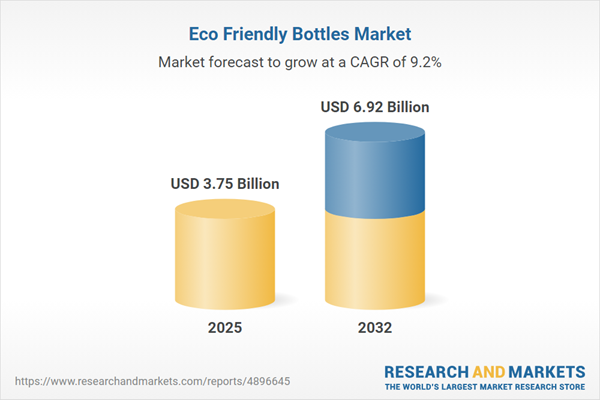Speak directly to the analyst to clarify any post sales queries you may have.
Eco friendly bottles are becoming a fundamental element in corporate sustainability efforts, as organizations seek practical ways to integrate environmental responsibility into daily operations and procurement practices. These solutions enable senior decision-makers to align hydration strategies with broader ESG goals and compliance requirements, supporting both long-term resilience and day-to-day operational efficiency.
Market Snapshot: Eco Friendly Bottles Market Size & Growth
The eco friendly bottles market reached a value of USD 3.43 billion in 2024, driven by a robust 9.15% compound annual growth rate. This growth is shaped by the adoption of sustainable hydration products across enterprise procurement programs and advances in material science. Organizational demand is spurring changes in procurement models, emphasizing the use of low-impact polymers and metals to meet corporate sustainability mandates. Strong regulatory alignment brings improved compliance and governance, while supplier consolidation standardizes hydration solutions throughout the organization. These dynamics create a supportive environment for enhanced procurement efficiency and continuous adaptation of sustainability practices in multiple sectors.
Scope & Segmentation: Eco Friendly Bottles Market
- Material Types: Aluminum, bamboo composites, borosilicate glass, soda lime glass, silicone, stainless steel blends, and Tritan are each benchmarked for lifecycle footprint, ethically sourced supply chains, and their fit within recycling or reuse frameworks.
- Product Types: Collapsible, filtered, insulated, and non-insulated bottles suit a range of uses, including business travel, in-office hydration, marketing initiatives, and employee wellness campaigns.
- Distribution Channels: Online procurement platforms, specialty retail, and supermarkets provide businesses with agile supply options and scalable sourcing models.
- End Uses: Products address corporate wellness, promotional gifting, event hydration, and recreational activities, supporting regulatory and employee safety expectations in varied settings.
- Price Ranges: Economy, mid-tier, and premium options support a spectrum of budgets while aligning durability and expected lifespan to procurement objectives.
- Capacities: Sub-500 ml to over 1000 ml volumes allow organizations to optimize for personal, group, or logistical demands, making inventory control more efficient.
- Age Groups: Adult and child-focused designs enhance ergonomic fit and safety for enterprise, education, or community use.
- Regional Coverage: The Americas, EMEA, and Asia-Pacific present diverse sourcing environments and regulatory landscapes, informing distinct implementation and compliance strategies for global enterprises.
- Profiled Brands: Leading suppliers include CamelBak Products, Hydro Flask, Klean Kanteen, Thermo Fisher Scientific, SIGG Switzerland, S’well, Newell Brands, Tupperware Brands, Lifefactory, and Manna Hydration, recognized for innovation in materials and responsible manufacturing processes.
Key Takeaways for Senior Decision-Makers
- Focusing on supplier transparency and managed partnerships mitigates compliance challenges and enables rapid adaptation to regulatory updates in different markets.
- Selecting stainless steel or bamboo bottle options enhances product durability and supports internal sustainability commitments, maximizing value over the product lifecycle.
- Integrating digital procurement tools and deploying refill station infrastructure offer flexibility in adapting hydration solutions to evolving internal distribution needs.
- Establishing circular economy practices, such as modular bottles and structured return initiatives, deepens stakeholder involvement and nurtures an enterprise-wide sustainability culture.
- Using digital tracking along with updated insulation materials allows organizations to better support diverse user needs as workspace requirements change.
- Building collaborative partnerships across the procurement value chain strengthens operational resilience, equipping teams to respond confidently to changes in regulation or supply.
Tariff Impact: Navigating Shifts in U.S. Policy
Shifts in U.S. tariff policies drive organizations to reevaluate sourcing decisions and adjust supplier networks. By employing diversification and nearshoring approaches, businesses can improve quality control and more quickly respond to regulatory or market fluctuations, ensuring steady access to eco friendly bottles as procurement environments shift.
Methodology & Data Sources
This analysis draws on direct executive interviews, expert industry input, and secondary research focused on procurement strategies and evolving material technologies. Validation from environmental organizations and academic advisors ensures findings accurately address the concerns and priorities of leadership teams within the eco friendly bottles market.
Why This Report Matters
- Delivers actionable insights to refine compliance and procurement processes for enterprises in the eco friendly bottles sector.
- Supports benchmarking by segmenting innovations in materials, product design, and sourcing models for better-informed supplier selection.
- Enables strategic planning by highlighting emerging risks and opportunities stemming from changing standards and buyer requirements regionally and globally.
Conclusion
Organizations that advance eco friendly bottle initiatives and modernize procurement workflows are positioned to strengthen corporate sustainability, manage evolving risks, and achieve resilient operational outcomes in a dynamic global context.
Additional Product Information:
- Purchase of this report includes 1 year online access with quarterly updates.
- This report can be updated on request. Please contact our Customer Experience team using the Ask a Question widget on our website.
Table of Contents
3. Executive Summary
4. Market Overview
7. Cumulative Impact of Artificial Intelligence 2025
Companies Mentioned
The companies profiled in this Eco Friendly Bottles market report include:- CamelBak Products, LLC
- Hydro Flask, LLC
- Klean Kanteen, Inc.
- Thermo Fisher Scientific Inc.
- SIGG Switzerland AG
- S'well, LLC
- Newell Brands Inc.
- Tupperware Brands Corporation
- Lifefactory, LLC
- Manna Hydration, LLC
Table Information
| Report Attribute | Details |
|---|---|
| No. of Pages | 192 |
| Published | November 2025 |
| Forecast Period | 2025 - 2032 |
| Estimated Market Value ( USD | $ 3.75 Billion |
| Forecasted Market Value ( USD | $ 6.92 Billion |
| Compound Annual Growth Rate | 9.1% |
| Regions Covered | Global |
| No. of Companies Mentioned | 11 |









